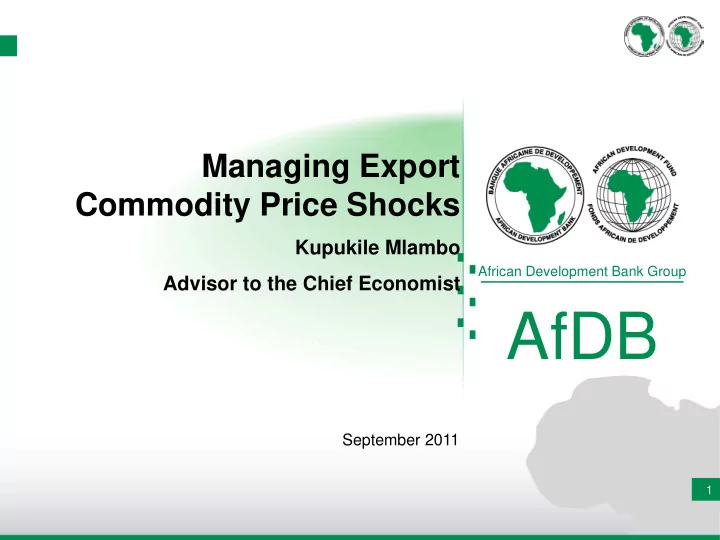

Managing Export Commodity Price Shocks Kupukile Mlambo African Development Bank Group Advisor to the Chief Economist AfDB September 2011 1
Presentation Outline Introduction: Good Growth News,…But Africa’s Exposure to Commodities Recent Price Developments in Key Commodity Markets Managing Commodity Price Shocks Some Challenges to Managing Commodity Price Shocks
Africa experiencing 10 years of dynamic growth Fastest growing economies: Angola, Nigeria, Ethiopia, Chad, Mozambique, 3 and Rwanda
But…. This is largely a commodity-driven growth Asia’s (principally China and India) growing demand for raw materials and rising commodity prices Paul Collier: the commodity boom in 2005 and 2006 added 2.5% to the growth of a typical African country
Commodity driven growth subject to booms and busts : Prices of commodities volatile Commodity prices in long-run circular decline vis-à-vis manufacturing and services Commodities also subject to other challenges Market access Value chain
II. Africa’s Exposure to Commodities Africa highly dependent on commodities In 2008, petroleum oils and natural gas accounted for 59.7% of total exports In 14 countries less than 3 products accounted for more than 75% of exports; and in 29 countries less than 5 products
Countries dependent on a single commodity for exports Commodity >50% of Exports 20-49% of Exports 10-19% of Exports Energy Algeria (61.6) DRC (25.5) Tunisia (12.3) Angola (76.5) Djibouti (21.1%) Cameroon (53.8) Egypt (20.4) Eq. Guinea (76.5) Liberia (23.2) Gabon (65.8) Senegal (29.9) Libya (88.4) Nigeria (85.2) Sudan (91.6) Metals CongoR(85.5-cobalt) Botsw ana (38.2-diamonds) Namibia (18- Guinea(50.2, aluminium) Mauritania (45.2-iron ores) natural Zambia (56.4, copper) Mozambique(36.6 alum) uranium) S-Leone(25.1%-diamonds) Zimbabw e(13.4- ferro- chromium) Agric BFaso(54.4-cotton) Benin(25.7 cotton) Chad(94-w ood) Burundi(45.7-cofee) G-Bissau(92.9-cashew ) Ethiopia(32.9-coffee) Malaw i (50.4-tobacco) Rw anda (30.4-coffee) SaoTome& P(64.1-cocoa Uganda (32.5-coffee) beans Cote d’Ivoire(28.6-cocoa) Ghana(42.8- cocoa) CAR(28.3-logs/w ood) Fisheries Seychelles (54.7) Cape Verde(36)
FAO food indices 2000-2010 100 150 200 250 300 350 400 50 0 Jan-00 Jun-00 Nov-00 Apr-01 Sep-01 Maize Feb-02 Jul-02 Dec-02 May-03 Palm oil Oct-03 Mar-04 Aug-04 Jan-05 Jun-05 Rice Nov-05 Apr-06 Sep-06 Feb-07 Soybeans Jul-07 Dec-07 May-08 Oct-08 Mar-09 Wheat Aug-09 Jan-10 Jun-10 Nov-10 Apr-11 9
Consequences of Commodity Price Shocks • Increase private investment uncertainty • Increase banking sector fragility • Adverse impact on Public Finances • Governance and Political instability
IV. Managing Commodity Price Volatility • Africa is exposed to different commodity classes: no one-size fits all • Management of commodity price shocks not to be restricted to a single strategy • Interventions should cover both supply and demand • For Africa, capacity building and technical assistance critical as well
IV. Managing Commodity Price Volatility Measures can be divided into • Short to medium term measures Stabilising markets (either through price or stock management) Market based approaches • Longer term measures Export diversification
Supply or Stock Management Price stabilisation through supply or stock management Countries set up buffer stock schemes: buy during slump in prices, and release stock when price rises OPEC is the most well known such scheme, which allocates quotas to member states. But also national schemes (marketing boards) Building of stocks hasn’t always worked well • Can be costly to manage • Difficult to assess the long-term equilibrium prices
Stabilisation Funds and SWF 1. Stabilisation funds act as a hedge against fluctuations in in the price of commodity exports They insulate public finances from commodity price volatility they can act as a form of saving for the future 2. Sovereign wealth funds are special purpose investment vehicles created to stabilise fiscal revenues and/or save for future generations Africa has at least 15 SWF (incl. Algeria, Chad, Angola, etc) Mostly sourced from oil, gas, minerals, and other natural resources African SWFs are predominantly driven by stabilisation motives 3. Challenges: most suffer from poor design and governance
Market-Based Approaches A. Commodity Derivatives: of two types Futures and Forwards Options, including Swaps Example: • Cocobod (Ghana) has been successful in using derivatives to stabilise cocoa revenues • Kilimanjaro Native Cooperative Union(Tanzania) also experimented with hedging in 2000-2002 • SAFEX is the largest; others in Kenya, Mauritius and Botswana Most commodity derivatives in Africa (except for SAFEX) have small trading volumes
B. Other Instruments Commodity-linked bonds • Can provide an opportunity for commodity-producing countries to hedge against large variations in export earnings—e.g. oil-linked bonds • Example: Standard Bank Group launched South Africa’s first commodity-linked exchange traded notes (ETNs) in 2010 • But markets for these instruments may be difficult to access for most African countries
ADB COMMODITY LINKED LOAN The AfDB has developed a COMMODITY LINKED LOAN instrument which so far is only available to countries able to borrow from the ADB Window. The commodity link loan may apply either to: • Interest payments only; Or • Principal payments only; Or Both the interest and the principal payments . • 18
Some Challenges facing Africa Small size Lack of Capacity Poor Market Infrastructure Regulatory barriers
THANK YOU Office of the Chief Economist African Development Bank 20
Recommend
More recommend